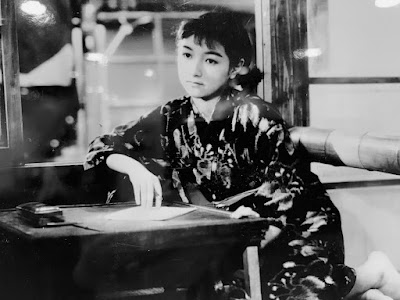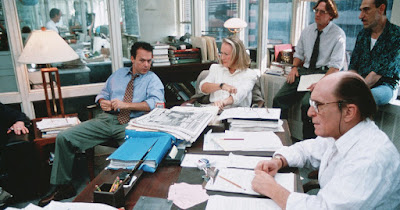It’s fascinating to witness the number of Japanese studio films from 1930s that focuses on the social and economic situation of the underclass. Yasujiro Ozu’s Passing Fancy (1933), An Inn in Tokyo (1935), The Only Son (1936), Mikio Naruse’s Each Night I Dream (1933), Three Sisters with Maiden Hearts, Sadao Yamanaka’s Humanity and Paper Balloons (1937), Hiroshi Shimizu’s Mr. Thank You (1936) are the few that immediately comes to mind. It all offers relatively complex tableau of underclass life which never sugar-coats their bleak reality. It would be interesting to read or know why these stories on under-privileged class had a box-office appeal. Kajiro Yamamoto’s Composition Class (Tsuzurikata kyoshitsu, 1938) is one such frank depiction of a low-income family’s life. Similar to all the aforementioned films, the narrative focuses on the humor, little triumphs and joys of everyday life rather than simply blanketing us with emotions of despair and sorrow.
My interest in Composition Class is obviously due to the reverence Akira Kurosawa expressed for writer/director Kajiro Yamamoto in his book, ‘Something Like an Autobiography’. In fact, Mr. Yamamoto is largely known as the mentor of Kurosawa rather than for his filmography. Under Yamamoto, Kurosawa learned everything about film-making, from script-writing, direction to editing and post-production process. In the four years he worked under the filmmaker, Kurosawa emerged from being third assistant director to the chief assistant director. In Composition Class, Kurosawa is credited as the ‘Chief Assistant Director’. Ishiro Hondo (Godzilla) was another important Japanese filmmaker to be mentored by Kajiro Yamamoto.
Of course, this is not the right method to approach a filmmaker’s work. Moreover, a lot of Yamamoto’s work haven’t survived or not readily available. Yet I am glad to have discovered Composition Class (1938) which shines due to Yamamoto’s screenwriting skills and elegant compositions. Though he might not have garnered critical praise for his staging like Mizoguchi, Ozu or Naruse, Yamamoto also ably embodies the Japanese concept of ‘Ma’ and ‘Mono no aware’.
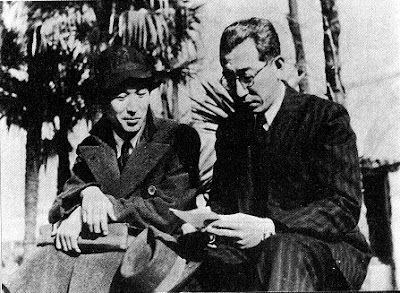 |
| Akira Kurosawa (left) with Kajiro Yamamoto |
The other important reason to watch Composition Class is Hideko Takamine, who plays the 12 or 13 year old protagonist Masako Toyoda. I have witnessed lot of her profound performances as strong-willed, independent heroines in the 1950s, particularly in the works of Mikio Naruse and Keisuke Kinoshita. But apart from Ozu’s 1931 silent drama Tokyo Chorus (where the 7-year old Takamine plays the daughter of the central character), this is one of her earliest films I have seen.
Composition Class’s narrative framing simple yet effective. Precocious sixth grader Masako Toyoda is encouraged to write observational essays about her everyday life by her compassionate teacher (Osamu Takizawa). Masako lives with her parents and two younger brothers in the poor neighborhood of Tokyo metropolis. Her father is an itinerant tinsmith who doesn’t find much work due to the economic downturn. And the little he earns he spends it on booze. They live in a weather-beaten shack alongside other low-income families.
The film opens with Masako returning home from school, asking her mother one sen to buy a confectionery from a street vendor. The parents gloomily talk about the eviction notice they have received. Silence pervades the home as the parents, Masako, and her younger brother brood over their upcoming days. Meanwhile, the family’s youngest boy badgers his mom and dad for one sen, and the noise of children following the vendor pierces this sombre silence. It’s a deeply felt moment of sorrow that conveys their impoverishment through apt framing and adequate use of silence and sound. This classical Japanese approach to film-making is oft found in the works of the great Ozu, Mizoguchi, and Naruse which gracefully transposes us to the narrative’s reality by simply observing the people in a particular scenario or environment.
Kajiro Yamamoto in that silent, observational moment makes us understand (or mentally occupy) their reality rather than showcase the anticipated emotions and then move on. What rest of the film-making world considers as unnecessary moments or movements paves way to profundity in the Japanese cinema (including the Studio Ghibli anime). The aforementioned sequence isn’t simply drama but comes close to capturing the sadness of the present; a mournful melody composed through series of glimpses. Interestingly, such moments in classic Japanese films precedes Bazin’s superb analysis of the scene that showcases young maid’s morning chores in Umberto D (1952). I am kind of getting carried away here, but the more classic Japanese cinema I watch, the more I am admire its precise staging techniques in spite of the other limitations.
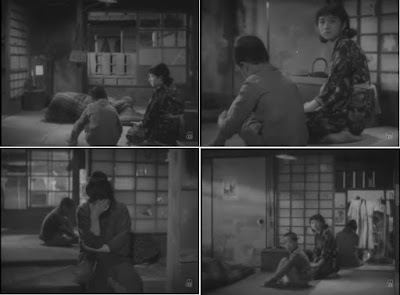 |
| A wonderful 'silent, observational moment' early in the film |
Unexpected humour, truths, and honesty are found in Masako’s essays. Soon, Masako learns that being honest also has consequences. In one of the essays, Masako writes about the rabbits she received from her neighbor lady. While mentioning this, she casually writes about what her neighbor lady said about the ‘stinginess’ of the Umemoto family. The teacher initially finds no problem with Masako’s honest observations. Furthermore, he sends it to a magazine and it gets published. Soon, Masako is reprimanded for being too honest with her descriptions, since Umemotos are his father’s chief employer and a family of considerable wealth.
The narrative is largely divided into three chapters, depicting the three class terms of sixth grader Masako. Though the crisis with Umemotos is resolved smoothly, the family is perpetually impacted by financial problems. And Masako’s viewpoint holds our attention throughout. Takamine’s performance in particular conveys a lot through elegant changes in posture and emotions. For instance, observe her in the scene when Masako’s mom asks her to become a geisha. When Takamine’s Masako returns home from school she finds her family having their meals. It’s a welcome sight after a long period of impoverishment and starvation. She’s rejoiced to see the rice bowl. However, once the mother talks about the perks of becoming a geisha, Masako understands the truth behind how they got the rice. Just look at how Takamine commands this scene with subtle change in expressions!
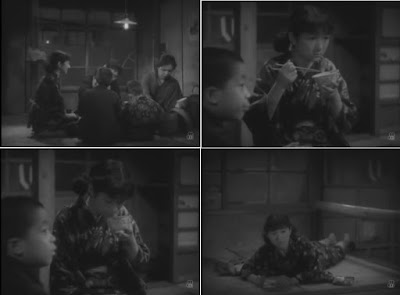 |
| The exceptional performance of Hideko Takamine |
The misfortune, however, is averted in a somewhat predictable manner. But writer/director Yamamoto doesn’t linger much with the drama. He thankfully rushes through the ending which tows the official messaging regarding Japan’s march towards modernization and industrialization (though it doesn’t over-sermonize). At the same time, Composition Class doesn’t throw an unimaginable miracle to rescue its protagonist. She escapes the disaster of a geisha life to become a factory worker. Masako mentions her classmates who are going to study further. There’s sadness in knowing that the girl couldn’t study further. But then the individuality she has established with her writing will probably help her in life’s stormy phases.
Composition Class is based on the collection of essays written by the real Masako Toyoda. I read that she became the poster girl of Japan’s modernizing education system and that many of her essays were published in the magazine ‘Red Bird’. Nevertheless, I couldn’t find much on what happened to Masako Toyoda later, during the war and post-war years. What's more we don’t get to know much about the teacher. In fact, his philosophy on teaching in itself was unique or even radical for its time. Encouraging self-expression instead of training students to do conventional compositions is a deviation from the tradition.
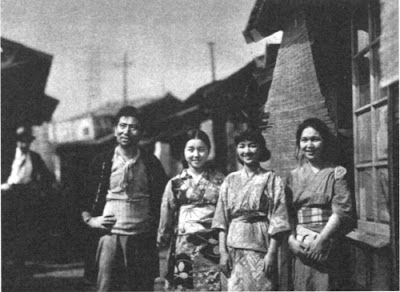 |
| Left to Right, Musei Tokugawa (father), Masako Toyoda, Hideko Takamine, and Nijiko Kiyokawa (mother) |
Eventually, apart from Takamine’s performance, Yamamoto’s unflinching depiction of poverty makes this narrative more memorable. This doesn’t mean visualizing the depressing facts about poverty in everyday life. Yamamoto captures how poverty impacts or drives one’s behavior. Masako’s embarrassment over buying rice with the coupons, the mother’s reprimand over the father’s carelessness in losing his bicycle or the tension that hovers during the father’s drunken behavior, Yamamoto’s vignettes always showcases the mental and emotional impacts of poverty. Yamamoto also sometimes finds humor in the bleakest of the situations. When the destitute neighbor lady suddenly starts praying to the ‘Lord’, the hungry children finds it a funny distraction. Moreover, this scene is intriguing for the mockery of this woman’s religious fervor. I am curious over the reasons behind such mockery out of nowhere. The family, however, in this scene observes someone who is worse off than themselves.
Overall, Composition Class (87 minutes) has lots of merits that make it a well-written and decently directed melodrama. Kajiro Yamamoto’s works probably deserves much more attention than just being a historical footnote while lionizing the film-making journey of the legendary Kurosawa.
Watch the full movie here:
